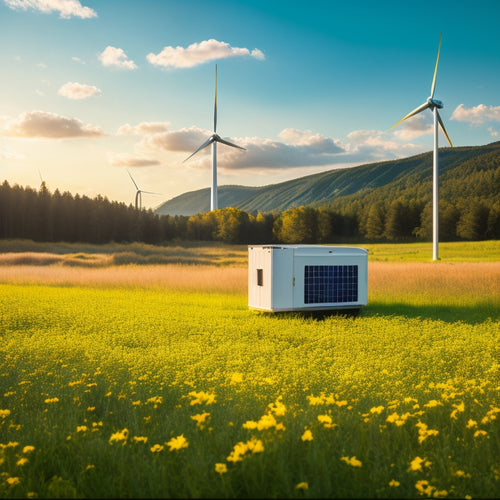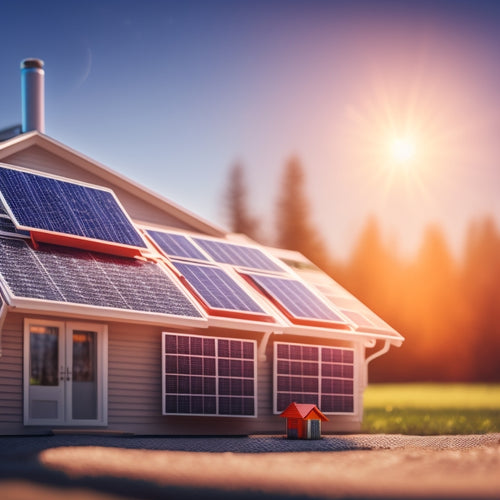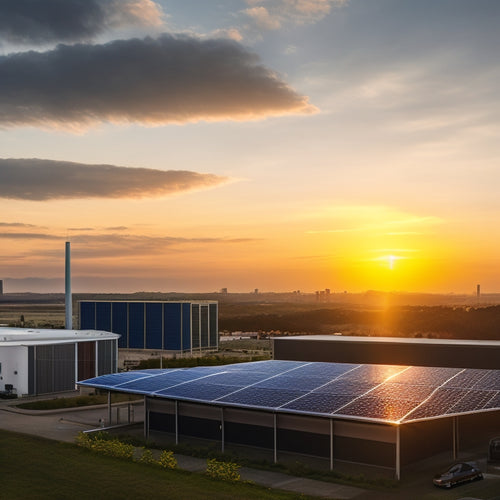
Solar Panel Efficiency in Cloudy Weather
Share
Solar panels can still generate substantial energy during cloudy weather by utilizing advanced technologies and proper positioning. High-efficiency panels, like monocrystalline types, excel in low-light conditions, maximizing energy capture from diffuse sunlight. Optimizing the tilt and orientation of your panels can further enhance performance, allowing for higher energy output even when sunlight is limited. Innovative designs, like bifacial panels, capture light from both sides, increasing overall efficiency. By understanding these factors, you'll not only reduce reliance on traditional energy sources but also improve energy independence, ensuring your solar setup remains productive under various weather conditions.
At a Glance
- Solar panels can still generate substantial energy during cloudy weather, particularly with proper orientation and tilt adjustments.
- Bifacial panels and advanced inverter systems are designed to optimize energy capture in low-light conditions, enhancing overall efficiency.
- Energy storage solutions, like solar batteries, help store excess energy produced during sunny periods for use during cloudy days.
- Regular maintenance, such as cleaning and inspections, ensures solar panels remain efficient by preventing debris from blocking sunlight.
- Understanding local climate and seasonal variations aids in optimizing solar array design for consistent energy production throughout the year.
Maximized Energy Output Potential
When evaluating solar panel efficiency during cloudy weather, you need to take into account various factors that influence energy output, such as panel orientation and shading.
Solar batteries can play an essential role in storing excess energy generated during sporadic sunny intervals, enhancing overall energy independence.
Innovative technology solutions, like bifacial panels and enhanced inverter systems, can greatly improve performance in less-than-ideal conditions.
Understanding these elements will help you maximize your energy output potential, even when sunlight is limited.
Factors Affecting Efficiency
Solar panel efficiency hinges on several important factors that can greatly influence their energy output potential, especially in cloudy weather.
First, consider panel positioning; proper alignment with the sun can mitigate shading effects and enhance performance. Angle adjustment plays a significant role too; adjusting the tilt of your panels can capture more diffuse sunlight during overcast conditions.
Seasonal variations must also be factored in. As the sun's path changes, your panels may need periodic adjustments to maintain ideal efficiency. Regional differences in weather patterns can dictate the effectiveness of your solar array design, impacting energy production throughout the year.
Maintenance practices shouldn't be overlooked either. Regular cleaning and inspections can prevent dirt and debris from accumulating, which can otherwise block sunlight and reduce output.
Additionally, temperature impacts play an essential role; cooler conditions can improve efficiency, but excessive heat can lead to a drop in performance.
Innovative Technology Solutions
Innovative technology solutions are revolutionizing solar panel efficiency, particularly in challenging conditions like cloudy weather. By utilizing solar innovations, manufacturers are enhancing cloud resilience through advanced panel design. This means you can expect higher energy output even when skies are overcast.
| Technology | Description | Benefits |
|---|---|---|
| Hybrid Systems | Combines solar with other energy sources | Increases reliability and efficiency |
| Energy Storage | Batteries that store excess energy | Provides power during low production |
| Advanced Panel Design | Optimized for low light conditions | Maximizes energy capture |
| Performance Monitoring | Real-time tracking of efficiency metrics | Enables proactive adjustments |
| Weather Forecasting | Predictive analytics for energy production | Improves grid integration |
These advancements not only optimize energy capture but also integrate seamlessly into existing energy grids. Sustainable materials used in these technologies contribute to a greener future, while performance monitoring guarantees you're always aware of your system's capabilities. The combination of these strategies allows you to utilize renewable energy more effectively, even when the weather doesn't cooperate. Embracing these solutions means equipping yourself with energy independence and sustainability.
Increased Energy Production Reliability
When considering energy production reliability, consistent energy generation is essential, especially during overcast conditions.
High-efficiency solar panels, as noted in reliable energy options, are designed to perform better in lower light conditions, guaranteeing you get the most out of your solar setup.
Advanced solar technologies, including bifacial panels and improved inverter systems, enhance your system's performance even in less-than-ideal weather.
Consistent Energy Generation
Many people underestimate the potential of solar panels to generate energy even in overcast conditions. In fact, modern solar technologies are designed to utilize diffuse light, allowing for consistent energy generation regardless of the weather. When you optimize your solar system, you improve its ability to capture this scattered sunlight, enhancing overall efficiency during cloudy days.
Incorporating effective energy storage solutions is essential too. With a well-designed battery system, you can store excess energy produced during sunnier periods, ensuring that you have a reliable power supply even when the sun doesn't shine. This not only increases your energy independence but also contributes to a more stable energy output, allowing you to power your life freely and sustainably.
Moreover, system optimization techniques, such as adjusting the angle of your solar panels or employing tracking systems, can further enhance energy production. By understanding these interactions, you can make informed decisions that maximize your solar investment.
In the quest for energy freedom, recognizing the capabilities of solar panels in less-than-ideal weather conditions is imperative, ensuring you're prepared for any scenario while reducing reliance on traditional energy sources.
Advanced Solar Technologies
As solar technology continues to evolve, advanced systems are emerging that greatly enhance energy production reliability, even under challenging conditions.
You'll find that solar panel advancements, particularly in photovoltaic innovations, are vital for maximizing output during cloudy weather.
One significant advancement is the development of bifacial solar panels, which can capture sunlight from both sides. This design not only increases energy production in low-light conditions but also effectively makes use of reflected light from surrounding surfaces.
Additionally, some manufacturers are integrating advanced materials that improve light absorption and conversion efficiency, ensuring you get more energy even when the sun isn't shining brightly.
Moreover, energy storage technologies are becoming more sophisticated, allowing you to store excess energy generated during sunny hours for use when conditions are less favorable.
Smart inverter technology also plays a key role by optimizing power output based on real-time weather data, ensuring that your system adapts quickly to changing conditions.
Cloud Adaptability and Performance
When evaluating solar panel performance in overcast conditions, you'll notice that not all technologies respond equally.
Advanced photovoltaic systems are designed to optimize energy capture even in low-light scenarios, ensuring a more reliable energy output.
Additionally, the effects of humidity on solar panel efficiency can also influence performance during cloudy weather, as moisture can affect electrical conductivity and lead to a decrease in overall system efficiency.
Understanding these technologies can help you maximize efficiency during cloudy days.
Performance in Overcast Conditions
Experiencing cloudy weather doesn't spell disaster for solar panel performance; in fact, modern solar technology has evolved to maintain efficiency even in overcast conditions.
When cloud cover blankets the sky, it doesn't entirely block sunlight; instead, it diffuses light, scattering it across a broader area. This light diffusion allows solar panels to capture energy from indirect sunlight, ensuring that your system continues to generate power.
While you might notice a decrease in energy production compared to sunny days, it's crucial to understand that many high-efficiency panels are designed specifically to perform under these conditions.
Advanced photovoltaic materials utilize the available light more effectively, converting a larger percentage of it into usable energy. Additionally, the angle and orientation of your solar panels can greatly influence performance during cloudy weather.
Technology for Cloudy Days
Modern solar technology has made considerable advancements in developing systems that excel in less-than-ideal weather conditions. Innovative solar panel design now includes materials and technologies that enhance performance on cloudy days. For instance, bifacial solar panels capture sunlight from both sides, maximizing energy absorption even with diffuse light. This adaptability is vital for maintaining energy production when direct sunlight is limited.
Moreover, advanced photovoltaic cells, such as those utilizing monocrystalline or thin-film technology, are engineered to optimize efficiency in low-light conditions. They can convert a higher percentage of available light into usable energy compared to traditional panels.
Energy storage solutions have also evolved, allowing you to utilize and store energy generated during cloudy periods. High-capacity lithium-ion batteries can effectively store excess energy, ensuring a consistent power supply when sunlight is scarce.
This integration of energy storage with solar technology enables you to enjoy greater energy independence, regardless of weather fluctuations.
Selecting Based on Weather Resistance
When selecting solar panels, consider the materials used for weather resistance, as this directly impacts their durability and efficiency.
Panels designed with advanced coatings and sturdy frames perform better under low light conditions, ensuring you maximize energy capture even on cloudy days.
Additionally, high-capacity solar arrays paired with reliable battery systems can store excess energy generated during sunny periods, providing a consistent power supply even when the sun isn't shining.
Weather-Resistant Panel Materials
Choosing the right materials for solar panels is essential, especially in regions prone to unpredictable weather patterns. You want to guarantee that your investment in solar energy pays off, and that starts with understanding the importance of panel durability and material innovation.
Different materials can greatly impact how well your panels withstand adverse weather conditions. Here's a breakdown of common materials used in weather-resistant solar panels:
| Material | Durability Rating | Benefits |
|---|---|---|
| Monocrystalline | High | Efficient in low light, long lifespan |
| Polycrystalline | Moderate | Cost-effective, decent performance |
| Thin-Film | Low | Flexible installation, lightweight |
| Glass-Fiber Reinforced | High | High resistance to impacts and corrosion |
| Bifacial | High | Captures light from both sides, versatile |
When selecting materials, consider how well they can resist hail, wind, and extreme temperatures. Innovations in material technology are clearing the path for stronger, more resilient panels that can adapt to various climates. By prioritizing weather-resistant materials, you're not just protecting your solar investment; you're embracing a future where energy independence thrives.
Performance Under Low Light
Understanding the materials used in solar panels directly influences their performance in low-light conditions, especially during overcast or rainy days. When you're considering solar panels, the efficiency of monocrystalline versus polycrystalline panels can greatly affect how well they capture sunlight under cloud coverage.
Monocrystalline panels typically perform better in low-light conditions due to their higher purity of silicon, allowing for better energy absorption.
The cloud coverage impact on solar energy production can't be overstated. With heavy cloud cover, it's essential to optimize your solar panel orientation. Proper alignment can maximize sunlight exposure, even when the sun's rays are diffused.
Panels facing south generally yield the best results, but slight adjustments might be necessary to counteract the effects of seasonal changes or local weather patterns.
Additionally, the inverter technology you choose also plays an important role. Advanced inverters can optimize energy production by adjusting to varying light conditions, guaranteeing you get the most out of your solar investment.
Higher Performance in Low Light
When evaluating solar panels, consider their performance in low light conditions, as this can greatly impact energy generation.
Many modern panels employ advanced technologies that enhance their efficiency under such circumstances, allowing you to maximize output even on overcast days.
Understanding these benefits can help you make informed choices that align with your energy needs.
Benefits of Low Light
Low light conditions, such as those found on overcast days, can surprisingly enhance the performance of solar panels. This phenomenon occurs due to the unique way solar cells respond to varying light intensity. In lower light conditions, solar panels can achieve better energy absorption compared to bright, direct sunlight. The reason lies in the reduced likelihood of overheating, which can diminish efficiency in high-intensity light.
When the sun's rays are diffused by clouds, the even distribution of light allows solar panels to capture energy more effectively without the detrimental effects of excess heat. You might find it interesting that some solar technologies, like monocrystalline panels, are specifically designed to perform well in low light scenarios. Their structure optimizes the conversion of photons into usable energy, even when the light isn't at its peak.
Additionally, lower light conditions can mitigate the risk of shading effects that often plague solar arrays. With reduced glare and better overall light management, you can maximize your energy output.
Embracing the benefits of low light can lead to a more reliable and efficient solar energy system, giving you greater freedom and independence in your energy choices.
Frequently Asked Questions
How Do Solar Panels Perform During Heavy Rain or Storms?
During heavy rain or storms, solar panels generally maintain performance, though rain impact can temporarily reduce energy output. Their storm durability guarantees they withstand harsh conditions, allowing you to enjoy renewable energy even in adverse weather.
Can Solar Panels Generate Electricity at Night?
You can't generate electricity directly from solar panels at night, but with solar storage systems, you can store excess energy during the day, providing nighttime energy access and enhancing your energy independence when the sun sets.
What Maintenance Do Solar Panels Require in Cloudy Conditions?
Think of your solar panels as resilient flowers in a cloudy garden. Regular cleaning techniques and performance monitoring guarantee they thrive, even when sunlight wanes, allowing you to capture energy and maintain independence.
Are There Specific Brands Better Suited for Cloudy Weather?
When considering brand comparison, you'll find that some brands excel in cloudy performance. Look for panels with high low-light efficiency ratings, as they can capture more energy even in less-than-ideal conditions, maximizing your freedom.
How Does Temperature Affect Solar Panel Efficiency in Overcast Conditions?
Temperature impacts solar panel efficiency by affecting electron movement within the cells. In overcast conditions, moderate temperatures can enhance performance, while extreme heat may hinder efficiency factors, ultimately influencing your energy production and system reliability.
Explore More
So, it's ironic that while many folks think cloudy days are a solar panel's worst nightmare, they're actually a testing ground for efficiency. Your panels can still capture energy, proving their reliability even when the sun hides. By choosing models designed for low light, you guarantee peak performance regardless of the weather. Embracing this adaptability not only maximizes your energy output but also challenges the notion that sunshine is the only route to effective solar power.
Related Posts
-

Sustainable and Eco-Friendly Generators for a Reduced Carbon Footprint
Sustainable and eco-friendly generators are perfect for cutting your carbon footprint and increasing energy efficienc...
-

A Beginner's Guide to Navigating the Solar Investment Tax Credit
You're eligible to claim a significant Solar Investment Tax Credit (ITC) of 30% of total installation costs, but mane...
-

Advantages of Commercial Solar Battery On-Site Storage
By investing in a commercial solar battery on-site storage system, you can greatly reduce your energy grid dependence...


